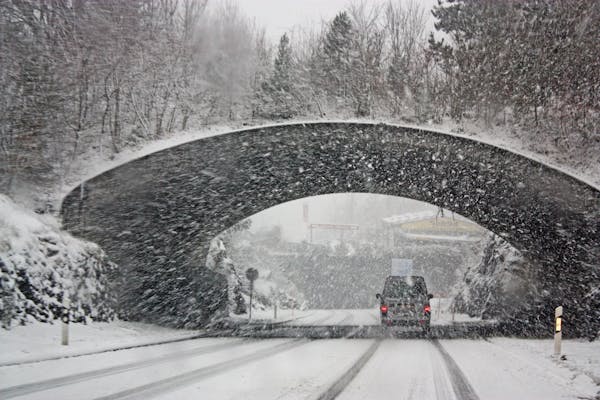Driving in the US can be unpredictable and deadly. On a daily basis, drivers have to be cautious about numerous road threats, from speeding to poor weather conditions that lead to fatalities.
The Federal Highway Administration says about 21% (or 1,235,000) of all car accidents are weather-related. That’s a huge number! But it’s not just rain or snow that can cause road trouble. Things like how the road is designed, sharp turns, and even fallen leaves can make driving more dangerous.
This blog post will explore these environmental hazards and how they contribute to car accidents. By understanding these risks, drivers can learn to stay safe, and policymakers can work towards better solutions. Let’s dive in and explore how weather and road conditions impact your safety behind the wheel.
Different Weather Conditions That Lead to Road Accidents
We know weather plays a role in crashes, but some conditions are more dangerous than others. Let’s break down how rain, snow, and fog pose unique challenges for drivers.
Snow and Ice
Winter weather presents drivers with challenges. Snow and ice transform roads into treacherous surfaces, drastically reducing tire traction and making it easy to lose control of your vehicle. Even experienced drivers can find themselves skidding when roads are icy. It’s essential to adjust your driving habits significantly during these conditions.
A study in ScienceDirect highlights that most road accidents occur after snowfall or at the beginning of snow and ice accumulation. Falling snow can limit how far you can see, making it hard to judge distances and react to hazards.
Blowing snow can be even worse, creating whiteout conditions that make it nearly impossible to see anything. If you encounter heavy snow or blowing snow while refinding, find a secure space and wait for the weather to clear.
For instance, consider the case of Jordan Matthews in Little Rock, Arkansas. Jordan was driving during a sudden snowstorm that made roads icy and unpredictable. Despite his cautious driving, another car lost control and crashed into him, causing significant damage to his vehicle and injuries to Jordan. The unexpected weather conditions had transformed his usual route into a hazardous journey, leading to an accident.
The consequences of such accidents extend beyond physical injuries. Victims often face emotional trauma, financial strain due to medical bills, and the cost of repairing or replacing their vehicles. In these situations, victims have the right to seek legal action to recover their losses.
Engaging a Little Rock car accident lawyer can help the victim navigate the complexities of filing a claim. An experienced lawyer will help gather evidence, negotiate with insurance companies, and represent the victim in court if necessary. They ensure that the victim receives fair compensation for their suffering and losses.
Victims can alleviate some financial burdens by taking legal action and focusing on recovery. Keith Law Group says legal support can provide peace of mind, knowing that an expert is handling the intricacies of their case. It allows them to rebuild their lives after such a traumatic event. Thus, consulting with a lawyer can be vital to achieving justice and compensation during a winter storm accident.
Fog
Fog is one of the most dangerous weather conditions. It can dramatically reduce visibility, sometimes to just a few feet. This makes it extremely difficult to see what’s ahead, including other vehicles, pedestrians, and the road itself. Driving in thick fog can feel like driving through a dense cloud, where everything is obscured. This limited visibility significantly increases the risk of accidents.
Rain
Rain dramatically changes driving conditions. It reduces visibility, making it harder to see other cars, pedestrians, and the roads. The water on your windshield and the spray from other vehicles can make it feel like you’re looking through a blurry window. This significantly increases the risk of accidents.
Moreover, rain also makes the roads slick. When rain falls on roads, it mixes with oil and dirt, creating a slippery film. This film makes it hard for tires to grip the road, which can cause hydroplaning.
Hydroplaning is when your tires lose contact with the road and slide on top of the water. A study published in NCBI reveals that many southern states in the USA have a higher risk of hydroplaning because of heavy rain, wide roads, and high-speed limits.
Other Factors That Lead to Road Accidents
Beyond the environment, other factors contribute to road accidents. Let’s explore some of the most common ones.
Sharp Curves
Sharp curves can be challenging for even the most experienced drivers. They require a different approach than driving on straight roads, demanding more attention and careful handling. As you navigate a curve, your vehicle is subject to centrifugal force, which pushes it outward. This can make it easy to lose control, especially if you’re traveling too fast or if the road is slippery.
A study found that sharper curves and steeper hills make accidents more dangerous. Specifically, drivers are 5.25% more likely to be injured on a right-turn curve than a left-turn curve. And 2.9% more likely to be injured going downhill than uphill around a curve.
Steep Grades
Steep grades present unique challenges for drivers, especially when controlling their vehicle’s speed. Gravity plays a significant role in inclines and declines. When traveling downhill, gravity pulls your car forward, accelerating it.
This can make it challenging to maintain a safe speed, especially for larger vehicles like trucks or buses. Use your brakes carefully and consider downshifting to a lower gear to help control your speed.
Poor Signage and Maintenance
Clear and effective road signage is essential for safe driving. Signs provide crucial information about speed limits, upcoming hazards, and road conditions. When signs are missing, damaged, or poorly placed, it can lead to confusion and uncertainty for drivers. This can cause drivers to make sudden maneuvers, increasing the risk of accidents.
Road maintenance is as important as signage. Potholes, uneven surfaces, and debris in the roadway can all pose hazards to drivers. Potholes can cause tire damage or even force a driver to swerve suddenly. Uneven pavement can affect a vehicle’s stability and make it harder to control. Debris in the road can create obstacles that drivers must avoid, potentially leading to dangerous maneuvers. Having all-weather spare tire covers is essential for protecting your spare in case of sudden road hazards, as they shield it from dirt and weather, ensuring you’re prepared when you need it most.
FAQs
What weather condition causes the most accidents?
Rainy conditions are the leading cause of weather-related accidents. Wet roads reduce tire traction, leading to longer stopping distances and higher chances of skidding. Reduced visibility from rain also hampers driver awareness. These factors increase the likelihood of collisions during rainy conditions compared to other weather-related hazards.
What is the biggest factor in road accidents?
Human error is the biggest factor in road accidents, accounting for most incidents. This includes distracted driving, speeding, impaired driving, and failing to obey traffic laws. Environmental factors and vehicle defects also contribute but to a lesser extent. Addressing human behavior is crucial to significantly reducing road accidents.
What are the causes of accidents in hilly areas?
Steep and winding roads, landslides, and falling rocks often cause accidents in hilly areas. Drivers may also be unfamiliar with the terrain, leading to excessive speed or improper handling of curves. Poor road maintenance and a lack of guardrails also contribute significantly.
As we’ve seen, the environment plays a massive role in road safety. From blinding rain to slippery leaves and poorly maintained roads, these factors can quickly turn a routine drive into a dangerous situation. But by understanding these risks, we can all become more responsible and aware drivers.
Remember to adjust your driving to the conditions. Slow down when visibility is poor, increase your following distance, and be prepared for unexpected hazards. Keep your car in good condition with properly inflated tires, working brakes, and bright headlights. And most importantly, stay focused on the road and avoid distractions.
By taking these precautions and being mindful of our surroundings, we can all contribute to safer roads for everyone. Drive safely!




